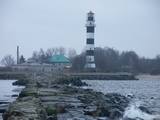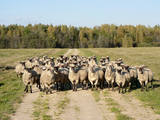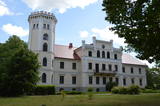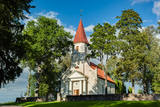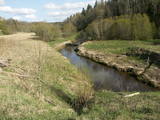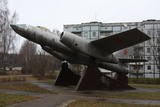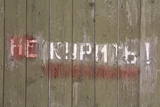| Nr | Name | Beschreibung |
|---|---|---|
|
Die 860 m lange Westmole (gebaut 1885) regelt zusammen mit der Ostmole die Mündung des Flusses ins Meer und reduziert die Verschlammung. Eine Holzpfahlbauweise bildet die Gründung der Wasseranlage, die mit Steinen befestigt ist. Die Mole wurde mehrmals rekonstruiert und befestigt. Im 19. Jahrhundert befand sich auf der Mole ein Zuchthaus. Während des Wiederaufbaus der Mole wurde etwa eine Hälfte der Mole betoniert. Das andere Teil befindet sich zurzeit im recht schlechten Zustand! Schon 1528 hat der König von Polen Stephan Báthory einen Erlass über den Bau eines Leuchtturms an der Mündung des Flusses Daugava verabschieden. Die erste Karte, auf der der Leuchtturm dargestellt ist, stammt aus dem Jahr 1536. In der Leuchtturm-Abrechnung des Russischen Reiches im Jahre 1721 wurde angezeigt, dass sich hier eine Anhäufung der Steine befindet, auf der man Feuer anbrennt. Später wurden Türme aus Holz und Stein gebaut, die während der Kriegszeit vernichtet wurden. Der jetzige Leuchtturm von Daugavgrīva wurde 1957 gebaut und ist 35 m hoch. Ein Lichtblitz ist aus einer Entfernung von 18 Seemeilen sichtbar. |
||
|
Der Bauernhof Pärnamäe auf der Insel Kihnu hat bereits viermal die Auszeichnung des schönsten Hauses gewonnen. Die Gastgeberin bereitet hausgemachtes Essen, traditionelles Kihnu-Brot und geräucherte Fische zu, die man auf dem Kihnu-Hafenmarkt kaufen kann. Unterkunft wird in drei bequemen Sommerhäusern angeboten. Im Winter werden hier die einzigartigen Kihnu-Teppiche gewebt. |
||
|
Der Waldweg führt über kleinere Wege um die lutherische Kirche Vangaži und die Werwolfkiefer. Auf dem Weg zum Jagdpalast passiert er den von der Opernsängerin Anna Ludiņa angelegten Garten und folgt dann dem Jagdpfad. Hier sind die ersten Seitenschluchten mit dem ausgeprägten Relief des alten Tals des Flusses Gauja zu sehen. Eine davon befindet sich bei Inčukalns Velnala (Teufelshöhle), umgeben von kleinen Flusskanälen der alten Gauja. Von dort führt der Waldweg durch Wiesen und überquert die Autobahn Murjāņi - Valmiera, auf der sich der Erholungspark „Rāmkalni“ befindet. In diesem Park gibt es ein Café, ein Geschäft und ein aktives Freizeitzentrum mit einer Schlittenbahn. Auf dieser Route sehen Sie hauptsächlich Kiefernwälder unterschiedlichen Alters sowie die botanische Plantage mit 80 Baum- und 120 Straucharten. Am Ende des Abschnitts befinden sich Sandsteinaufschlüsse - devonische Sedimentgesteine und in Lettland geschützte Lebensräume. |
||
|
Находится в Пастари, примерно на расстоянии 2,5 км от дороги Прейли - Виляны, в самом высоком месте с красивейшим пейзажем на Латгальскую возвышенность. Ветряная мельница голландского типа (с вращающимся механизмом крыльев) построена в 1902 году. В 2012 году были восстановлены крылья ветряной мельницы. По предварительной договоренности мельницу можно осмотреть изнутри. |
||
|
Einer der größten Weingärten in Lettland mit über 50 Rebsorten. Bei den angebotenen Führungen erzählt der Winzer über den Anbau von Wein und konsultiert bei Fragen zum Thema. Weiterhin gibt es Verkostungen und man kann Rebstöcke kaufen. |
||
|
Saldus ist in den historischen Quellen schon im Jahr 1253 erwähnt worden. Bis zum 13. Jh. befand sich hier die alte Burg der Kuren Salden, die auch im Wappen der Stadt dargestellt ist. Um 1341 hat der Livländische Orden unweit von dem Burgberg der Kuren eine Burg gebaut, an der sich eine Siedlung herausgebildet hat. Wie andere Ortschaften von Kurland hat Saldus ihre Blütezeit während der Regierungszeit des Herzogs Jacob von 1642 bis 1682 erlebt. Als das Gründungsjahr von Saldus wird das Jahr 1856 genannt, als mit den Erneuerungsarbeiten des im Nordischen Krieg zerstörten Ortes begonnen wurde. Am Ende des Zweiten Weltkriegs ereigneten sich in der Nähe der Stadt schwere Kämpfe, aber bis zum 8. Mai 1945 blieb die Stadt in dem Teil von Lettland, der von der deutschen Armee besetzt war. Heute zieht die Stadt Saldus mit ihren Veranstaltungen – mit den Stadttagen, mit dem Musikfestival Saldus Saule (Die Sonne von Saldus), sowie mit verschiedenen Sehenswürdigkeiten an, unter denen man die Druvas pārtika AG, wo man den Prozess der Eisherstellung beobachten kann, und die Saldus pārtikas kombināts GmbH nennen kann, wo man die leckeren Bonbons Gotiņa probieren und den Herstellungsprozess beobachten kann. |
||
|
Auf den umliegenden Feldern der Wirtschaft, die in dem Dienerhaus des ehemaligen Landgutes von Ķempēni haust, weiden mehr als 200 Lettische Schwarzköpfige Schafe (diese Rasse wurde in Lettland in den 1920er bis 1930er Jahren gezüchtet). Hier kann man Fleisch, Wolle und Felle kaufen, sowie an einer Führung mit Verkostung teilnehmen. |
||
|
Das Restaurant befindet sich im Park von Smiltene: im Tal des Flusses Abuls, in der ehemaligen Brauerei des Landgutes. Nebenan befindet sich die Brauerei von Smiltene, wo Zider hergestellt wird, darum können Gäste diesen Apfelwein und auch einen Hauswein verkosten, der aus einheimischen Beeren hergestellt ist. Lettische Küche: Kalte Suppe, Schweinfleisch mit Zwiebeln, Kartoffelpfannkuchen, geschichtetes Roggenbrot-Dessert, Haferflocken mit Schlagsahne. Das besondere Gericht: Brauhaus: Eine gefüllte Schweinfleischrolle. |
||
|
In der Zauberküche werden leckere Speisen aus den in der Gegend angebauten Produkten angeboten. Sie sollen unbedingt die Brennesselsuppe kosten, die als die beste südestnische Suppe gilt. Nõiariik ist für die aktive Erholung sowohl für Familien als auch für größere Gruppen geeignet. |
||
|
Skaistā ēka atrodas Lizuma centrā. Lizuma muižas īpašumi piederējuši dažādām dzimtām – vācbaltiešiem Tīzenhauzeniem, Malamiem un Volfiem. 1836. g. muižu iegādājas barons Otto Gotlībs fon Volfs, kura laikā muižas pils iegūst tagadējo veidolu – Tjudoru neogotikas stilu ar poligonālu torni. Jau no 1937. g. pilī izvietojusies Lizuma skola, kas ir viens no iemesliem, kādēļ saglabājusies ne tikai pati ēka, bet arī atsevišķi interjera elementi kāpņu telpā, Zilajā (Mednieku) zālē u.c. Pili ieskauj parks, kur atrodas muižas saimniecības ēkas – mūra klēts (te kultūras nams), 1876. g. celtais zirgu stallis (sporta halle), kalpu un dārznieka namiņš u.c. Bijušajā spirta brūzī ražo Gotiņas konfektes. Pils tornī izveidots Lizuma vidusskolas veidotais novadpētniecības muzejs. |
||
|
Pastāv uzskats, ka tieši Rubenē izveidojusies pirmā latviešu draudze. Baznīcas altārdaļa būvēta jau 14.gs., bet pati baznīca savu pašreizējo izskatu ieguvusi 1739. gadā.Būtiska baznīcas interjera sastāvdaļa ir Ķieģeļu muižas mantinieces Barbaras Helēnas fon Budbergas 1762. gadā dāvinātais kroņlukturis ar Krievijas impērijas divgalvaino ērgli un zaru ornamentiem uz bumbas. Baznīcā redzama arī zīme (1869. g.), kas ir veltīta pusgadsimtam kopš dzimtbūšanas atcelšanas. Pastāv vairākas teikas par Rubenes baznīcas nosaukuma rašanos. Viena no tām vēsta, ka, sargājot baznīcu no velna, tās sienā iemūrēta sieviete un vīrietis, kura vārds bijis Rubens. Baznīca esot nosaukta viņam par godu.Vēl viena versija vēsta, ka baznīcas nosaukums cēlies no rubeņa, kas sēdējis kādā no kokiem, kas vēlāk izmantots baznīcas celtniecībā. |
||
|
Das Gästehaus „Stikāni“ befindet sich 2 km von Nagli entfernt am Rand der Oreniši-Fischteiche. Im Gästehaus gibt es 4 bestens ausgestattete Doppelzimmer und ein Wohnzimmer mit Ausgang zur Terrasse. Auf dem zum Haus gehörenden Territorium ist ein Lehrpfad eingerichtet, wo man mit Führung mit den für Lettland typischen Bäumen und Sträuchern bekannt gemacht wird, ebenso mit den bekannten und mit weniger bekannten Heilpflanzen. Im Sommer auch mit den brütenden Vögeln im Frühling oder Herbst mit den hier reichlich anzutreffenden migrierenden Vögeln. |
||
|
Riežupes dabas parks veidots g.k. Riežupes izteksmīgās ielejas, tai raksturīgo dabas vērtību – nogāžu un gravu mežu, dažādu ģeoloģisku dabas pieminekļu - smilšakmens atsegumu, alu, ūdenkritumu, upes straujteču posmu, dažādu sugu, mežu masīvu un ainavas aizsardzībai. Parka atrodas viens no Kurzemes populārākajiem tūrisma objektiem – Riežupes alas - garākais mākslīgo alu labirints Latvijā, kura eju kopgarums ir 460 m. Sākotnēji dabas veidotās alas 19. gs. vidū mākslīgi paplašināja baltās smilts ieguves nolūkos, kuras izmantoja stikla ražošanai. Parkā izveidots velotūrisma maršruts. |
||
|
Zusammen mit der Stadt Valga in Estland ist Valka eine einzigartige grenznahe Zwillingsstadt. |
||
|
Die Haupttätigkeit des bäuerlichen Betriebs ist Getreidezucht. Seit 2006 beschäftigt sich der Betrieb mit Milchviehzucht und seit 2008 – mit der Herstellung von Käse und Quark. Zur Zeit sind im Betrieb mehr als 200 Melkkühe, von deren Milch Rohmilch, Joghurt, Käse und Eis hergestellt werden. |
||
|
Das Café befindet sich in der Nähe der evangelisch lutherischen Kirche von Talsi. Lettische Küche: Bohnensuppe, Ampfersuppe, kalte Suppe, Graupengrütze, Erbsenbrei, Gerstengrütze, geschmortes Gemüse, geschmortes Fleisch, hausgemachte Frikadellen, graue Erbsen mit Speck, Schweinerippen, Kartoffelpfannkuchen, Himmelsbrei, Kompott mit Milch. |
||
|
Im Dorf von Skulte ist ein seltenes Denkmal erhalten geblieben – Düsenflugzeug (Bombenflugzeug) aus der Zeit der Sowjetunion IL-28), das möglicherweise auch die geflügelten Raketen tragen könnte. Das Flugzeug ist auf drei betonierten Postamenten aufgestellt.
|
||
|
Ein weites Territorium im Süden von Pāvilosta, wo die ehemaligen vereinten Lagerhäuser und Erdölstationen gelegen sind. Zur Zeit wird das Territorium als Gewinnungsplatz der Baustoffe und Werkstatt der Holzbearbeitung genutzt. In der Nähe des Territoriums sind Warnungszeichen "Gefährlich, lebensgefährlich!" aufgestellt.
|
||
|
The loveliest views of the local cultural and historical treasures (the Āraiši lake castle, the Lutheran church, the parsonage, Medieval castle ruins – all of these cultural monuments). The hillocks of the area which offers this view can be found in the immediate proximity of the Āraiši windmill and the Drabeši-Āraiši road.
|
||
|
Just 20km from Valmiera down the river Gauja in Gauja National park theritory we own fabilous place for lovers of leisurely holidays with good active tourism possibilities. Main building with kitchen, shower, WC and higher standard accomodation possibilities. Big shelter with lodges next to it. Big area with fireplace. Sleeping facilities in 2 nd floor and some extra sleeping facilities and big shelter in separate building. There are You can find marked bicycle trail Valmiera-Cēsis next to the CAMP CAUNĪTES. Guests can use canoes for fishing or short tours along the river Gauja. |
||
